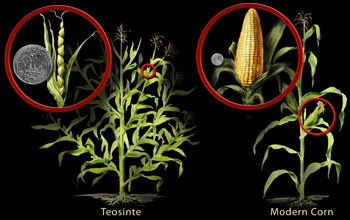All Images
News Release 05-088
Scientists Trace Corn Ancestry from Ancient Grass to Modern Crop
Indigenous farmers bred the plant for hardiness and better food quality
This material is available primarily for archival purposes. Telephone numbers or other contact information may be out of date; please see current contact information at media contacts.

Cultivated corn was domesticated from teosinte more than 6,000 years ago. During the process, corn lost the ability to survive in the wild, but gained valuable agricultural traits. The suppression of branching from the stalk resulted in a lower number of ears per plant but allows each ear to grow larger. The hard case around the kernel disappeared over time. Today, we see just a few ears of corn growing on one unbranched stalk and enjoy larger ears covered with many, many rows of soft corn kernels.
Credit: Nicolle Rager Fuller, National Science Foundation
Download the high-resolution JPG version of the image. (552 KB)
Use your mouse to right-click (Mac users may need to Ctrl-click) the link above and choose the option that will save the file or target to your computer.

Native Americans living in what is now Mexico began domesticating teosinte, or "grain of the gods," more than 6,000 years ago. By selectively breeding each generation, ancient farmers drastically changed teosinte's appearance, yield, grain quality and hardiness, culminating in today's corn.
Credit: Library of Congress, LC-USZ62-46945
Download the high-resolution JPG version of the image. (160 KB)
Use your mouse to right-click (Mac users may need to Ctrl-click) the link above and choose the option that will save the file or target to your computer.
